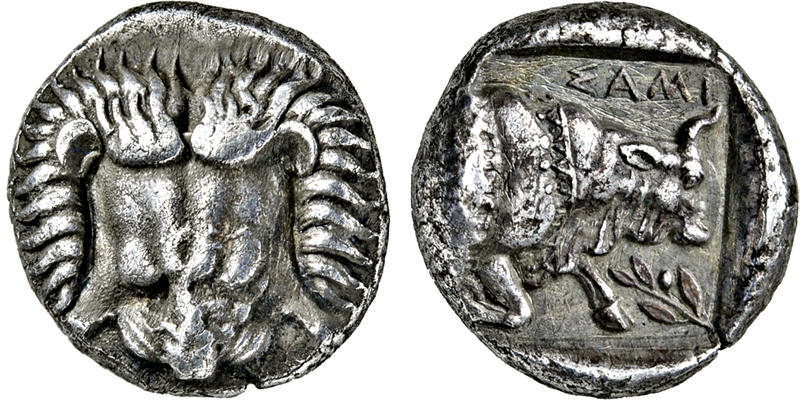AC 231g - Samos, silver, drachms (412-404 BCE)
From SILVER
412 BCE - 404 BCE Silver 183 kg
Description
| ObverseInscription or printing placed on the obverse.: | Lion's Scalp. |
| ReverseInscription or printing placed on the reverse.: | Forepart of bull right, below olive branch. All within incuse square. |
Mint and issuing power
| MintIdentifies the place of manufacture or issue of a numismatic object.: | Samos | Ancient regionAncient region.: | Ionia (islands) | Modern countryModern country: Turkey | AuthorityIdentifies the issuing power. The authority can be "pretended" when the name or the portrait of X is on the coin but he/she was not the issuing power. It can also be "uncertain" when there is no mention of X on the coin but he/she was the issuing power according to the historical sources: |
Chronology
| FromIdentifies the initial date in a range assigned in a numismatic context. | 412 BCE | toIdentifies the final date in a range assigned in a numismatic context.. | 404 BCE | PeriodTime period of the numismatic object.: Classical 480-323 BC |
Physical description
| MetalThe physical material (usually metal) from which an object is made.: | Silver |
Median weightMedian of the weights of numismatic objects (in grams). in grams | 4.20 | DenominationTerm indicating the value of a numismatic object. Examples: tetradrachm, chalkous, denarius.: | drachma |
StandardStandard.: | Attic |
Image

AC231g Samos.jpeg [1]
References
| Die study referencePublication of the study: | Barron 19661Barron 1966 | ||
| Coin series referenceReference to coin series study: | Sear II2Sear II, n° 4640, RQEMAC3RQEMAC, n° 231g | ||
| Coin series web referenceCoin series web references: | |||
Obverse dies distribution
no distribution is available
Reverse dies distribution
no distribution is available
Quantification
| Number of obversesNumber of obverse dies. ᵖ (o) | 2 | Number of singletons (o1)The number of singleton coins. ᵖ | |
| Number of reverse diesNumber of reverse dies. (r) | 5 | Number of coinsNumber of coins. (n) | 11 |
| Coins per obverse dieNumber of coins per obverse die. (n/o) | 5.5 | Coins per reverse dieNumber of coins per reverse die. (n/r) | 2.2 |
| Reverse per obverse ratioRatio of obverse dies divided by reverse dies. (r/o) | 2.5 | Percentage of singletons (o1)number of coins (n) divided by the number of singletons (o1) ᵖ | % |
| Original number of dies (O) (Carter 1983 formula)The estimation of the number of coins according to Carter 1983 ᵖ | 2.18 | Coins struck if 20,000 as average productivity per dieCoins made if the average productivity for obverses (according to Carter) is 20,000. ᵖ | 43,600 |
| Original number of dies (O) (Esty 2011 formula)The estimation of the number of coins according to the singleton formula in Esty 2011 ᵖ (O) | 2.44 | Survival rate if 20,000 as average productivity per dieSurvival rate if average productivity is 20,000. ᵖ | 0.00025 |
| Coverage (o = % of O) (Esty 1984 formula)Esty 1984 - coverage (% of O) ᵖ (o = % of O) | % | Die productivity if survival rate 1/2,000Average productivity if survival rate is 1/2,000. ᵖ | 10,091.74 |
| Weight of silver (in kg) if 20,000 coins per die (O = Carter formula)Carter 1983 * Median weight * 20000 (*10 if gold or electrum) ᵖ | 183 kg <br /> 183 kg | Die productivity if survival rate 1/5,000Average productivity if survival rate is 1/5,000. ᵖ | 25,229.36 |
Remarks
References
- ^ Barron, John Penrose (1966), The Silver Coins of Samos, London, xii, 244 p., 32 pl.
- ^ Sear, David R. (1979), Greek coins and their values. Vol. II, Asia and North Africa, London, xlviii, p. 317-762
- ^ Callataÿ, François de (2003), Recueil quantitatif des émissions monétaires archaïques et classiques, Numismatique Romaine, Wetteren, VII + 267 p.